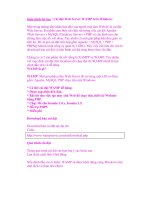Giáo trình tin học Chương I
Bạn đang xem bản rút gọn của tài liệu. Xem và tải ngay bản đầy đủ của tài liệu tại đây (188.63 KB, 26 trang )
2003 Prentice Hall, Inc. All rights reserved.
1
Chapter 1 – Introduction to C++
Programming
Outline
1. History of C and C++
2. C++ Standard Library
3. Basics of a Typical C++ Environment
4. Introduction to C++ Programming
5. A Simple Program: Printing a Line of Text
6. Another Simple Program: Adding Two Integers
7. Arithmetic
8. Decision Making: Equality and Relational Operators
9. Introduction to Object Technology
2003 Prentice Hall, Inc. All rights reserved.
2
History of C and C++
• History of C
– Evolved from two other programming languages
• BCPL and B
– “Typeless” languages
– Dennis Ritchie (Bell Laboratories)
• Added data typing, other features
– Development language of UNIX
– Hardware independent
• Portable programs
– 1989: ANSI standard
– 1990: ANSI and ISO standard published
• ANSI/ISO 9899: 1990
2003 Prentice Hall, Inc. All rights reserved.
3
History of C and C++
• History of C++
– Extension of C
– Early 1980s: Bjarne Stroustrup (Bell Laboratories)
– “Spruces up” C
– Provides capabilities for object-oriented programming
• Objects: reusable software components
– Model items in real world
• Object-oriented programs
– Easy to understand, correct and modify
– Hybrid language
• C-like style
• Object-oriented style
•Both
2003 Prentice Hall, Inc. All rights reserved.
4
C++ Standard Library
•C++ programs
– Built from pieces called classes and functions
• C++ standard library
– Rich collections of existing classes and functions
• “Building block approach” to creating programs
– “Software reuse”
2003 Prentice Hall, Inc. All rights reserved.
5
Basics of a Typical C++ Environment
• C++ systems
– Program-development environment
– Language
– C++ Standard Library
2003 Prentice Hall, Inc. All rights reserved.
6
Basics of a Typical C++ Environment
Phases of C++ Programs:
1. Edit
2. Preprocess
3. Compile
4. Link
5. Load
6. Execute
Loader
Primary
Memory
Program is created in
the editor and stored
on disk.
Preprocessor program
processes the code.
Loader puts program
in memory.
CPU takes each
instruction and
executes it, possibly
storing new data
values as the program
executes.
Compiler
Compiler creates
object code and stores
it on disk.
Linker links the object
code with the libraries,
creates a.out and
stores it on disk
Editor
Preprocessor
Linker
CPU
Primary
Memory
.
.
.
.
.
.
.
.
.
.
.
.
Disk
Disk
Disk
Disk
Disk
2003 Prentice Hall, Inc. All rights reserved.
7
Basics of a Typical C++ Environment
• Input/output
– cin
• Standard input stream
• Normally keyboard
– cout
• Standard output stream
• Normally computer screen
– cerr
• Standard error stream
• Display error messages
2003 Prentice Hall, Inc. All rights reserved.
8
Introduction to C++ Programming
• C++ language
– Facilitates structured and disciplined approach to computer
program design
• Following several examples
– Illustrate many important features of C++
– Each analyzed one statement at a time
• Structured programming
• Object-oriented programming
2003 Prentice Hall, Inc. All rights reserved.
9
A Simple Program:
Printing a Line of Text
• Comments
– Document programs
– Improve program readability
– Ignored by compiler
– Single-line comment
• Begin with //
• Preprocessor directives
– Processed by preprocessor before compiling
– Begin with #
2003 Prentice Hall, Inc.
All rights reserved.
1 // Fig. 1.2: fig01_02.cpp
2 // A first program in C++.
3 #include <iostream>
4
5 // function main begins program execution
6 int main()
7 {
8 std::cout << "Welcome to C++!\n";
9 //indicate that program ended successfully
10 return 0;
11 } // end function main









